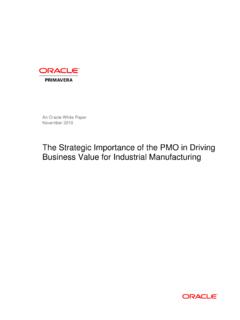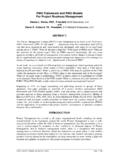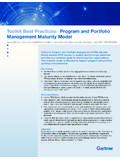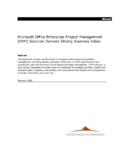Transcription of Effective human resource utilization for service delivery ...
1 International Journal of Scientific and Research Publications, Volume 4, Issue 12, December 2014 1 ISSN 2250-3153 Effective human resource utilization for service delivery improvement: The need to re-balance organizational and an employee s objectives realization. Kisumbe, L ;Sanga, D ;Kasubi, Local Government Training Institute (LGTI), 1125, Dodoma, Tanzania. Abstract- The paper presents an analysis on human resources utilization and the need to re-balance the realization of organizational and employee s objectives.
2 A sample of 40 employees was drawn for the purpose of the study of which 10 respondents were drawn from Local Government Training Institute (LGTI) and 30 from Prime Minister s Office-Region Administration and Local Government (PMO-RALG). Questionnaires and interview guides were employed in collecting primary data. Also, secondary data were collected from various sources with the aim of identifying the gaps to fill in. The data were analyzed through the use of SPSS version The findings in a great extent revealed ineffective human resource utilization in government offices, the drivers being the least utilized.
3 The reasons include inter-alia:- assignment of inadequate works to employees, Perdiems allowance triggering employees to keep on soliciting for the same and truancy accompanied with lack of clear close follow up. Moreover, it was learned that government offices do not balance the realization of organizational and employee s objectives. The organizations had not identified employees needs; there were no clear and reliable incentive schemes. Furthermore, training which could have been perceived as an attempt to balance between the two, was affected by lack of transparency in selecting the candidates, hence, it was rather depending on dyadic relationship between the two.
4 In order to address the above situation, the following are among the recommended steps:- development of clear and reliable incentive schemes; undertake job descriptions reviews to widen the scope and identification of employees objective and preparation of plans for its realization. Index Terms- Effectiveness, human resource utilization , service delivery improvement, Re-balancing the organizational and employee s objectives. I. INTRODUCTION mployees are very important assets of an organization whose well management together with commitment and employment of other assets of the organization, facilitate to the realization of the organizational objectives.
5 It is through their deliberate efforts other assets like machines can be used to produce the expected products. In other words, no matter how much is invested in technology and other modern assets, the achievement of organizational goals and realization of its objectives, highly depends on the Effective utilization of qualified and committed human resource as drivers of other resources. In Tanzania the emphasis on the importance of human resources as a key source of development in the country was put forward by the first president of the country who pointed out that everybody wants development; but not everybody understands and accepts the basic requirements for development.
6 The biggest requirement is hard work. Let us go to the villages and talk to our people and see whether or not it is possible to work It would be more appropriate for us to spend time in the village showing the people how to bring about development rather than going on so many long and expensive journeys abroad in search of development money (Nyerere, 1977:32). On the basis of the above views, hard work, accompanied by increasing the number of working hours is among the indispensable requirements for development.
7 The focus by then was to utilize the idle manpower in the search of development. However, despite the above fact, yet there are various problems hindering the Effective utilization of an employee in the organization. This has been supported by David Hume, of the 18th century, as quoted by URT (2004), who declared that the main problem with the Africans is that they don t have what it takes to get organized. In other words ineffective human resources utilization by various organizations results from inability to organize and sensitize the human resources for achievement of organizational goals.
8 Since independence, various government departments, agencies and institutions have been committing and spending enormous amount of money in training to improve human resource productivity which would in turn lead to service delivery improvement in particular and poverty alleviation in general, yet service delivery improvement has not been realized. This is supported by Maliyamkono and Manson (2006:372) who pointed out that a third of Tanzanians are living in absolute poverty, while some 20% in abject poverty.
9 In conjunction with the training, other deliberate efforts undertaken by various organizations in the world include among other things: - how to treat, perceive and manage employees of the organization. In attempt to realize the above, management of employees in the organizations started in 19th and early 20th century by employers with paternalist outlook who appointed welfare officers to manage series of initiatives designed to make life less harsh for their employees through the designing and provision of E International Journal of Scientific and Research Publications, Volume 4, Issue 12, December 2014 2 ISSN 2250-3153 unemployment benefits, sick pay leave and subsidized housing (Torrington.)
10 2008:11). Other factors led into the need to manage employees in organizations included the need to increase labour productivity during the first world war; development and recognition of personnel management as a valuable discipline in 1960s and intense business competition which led to great dependence on technologies leading to the need of employing multi skilled labour to apply the said technology in the production of goods and services (Graham and Bennett, 1998:3). Generally, these led to development and recognition of personnel management as important discipline in managing organizations.
















